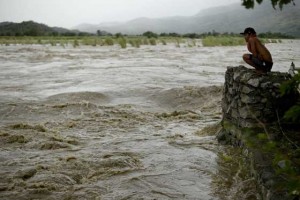TYPHOON Lando (international name: Koppu) isolated several communities in Luzon as it wrecked roads and bridges, downed power and communication lines and triggered landslides and floods in several northern provinces, forcing thousands of people to flee their homes.
A teenager died and four others were injured when a tree came crashing down on their house in Quezon City.
At least eight people were reported missing and rescue operations are underway in the province of Nueva Ecija, where rivers burst their banks and flooded several villages, regional authorities said.
“People are asking for help because the floodwaters are rising. The rescuers cannot penetrate the area as of now,” Nigel Lontoc, regional assistant civil defense chief, said.
Television footage showed raging brown rivers swallowing up homes and carrying off large debris including tree trunks.
The National Disaster Risk Reduction and Management Council (NDRRMC) on Sunday reported that 16,489 people in three cities and 32 municipalities in 11 provinces were evacuated.
Officials said more are expected to flee as the storm makes its way to the northern tip of Luzon.
Floods and landslides left more than a dozen roads and 10 bridges impassable to all types of vehicles.
Power was cut off in the provinces of Pangasinan, Cagayan, Isabela, Quirino, Nueva Vizcaya, Aurora, Nueva Ecija, Apayao and Kalinga while intermittent power interruptions were reported in San Fernando City, La Union and 18 municipalities in Regions 1, 3 and 4-A.
Disaster mitigation teams were instructed to provide satellite telephones in areas where communication lines bogged down.
Lando made landfall before dawn on the remote fishing town of Casiguran, Quezon, whipping the coast with gusts of up to 210 kilometers per hour for nearly seven hours before moving inland.
“Koppu tore off roofs of homes made of light materials. Rivers overflowed, and the roads to the area are blocked by downed power pylons and trees,” Lontoc said.
The typhoon later crossed over the Pantabangan dam in the southern foothills of the Cordillera, the country’s largest mountain range, with gusts of 185 kilometers per hour.
“Some villages are no longer accessible... I was told that rescuers saw two human bodies floating in the water,” Aurelio Umali, governor of Nueva Ecija province, said in a television interview.
Lontoc said the two bodies have not been recovered.
Three people in the coastal resort town of Baler, near Casiguran, are missing after a large wave struck their house, he added, and three fishermen are also missing on Manila Bay.
Flood warning
The typhoon weakened slightly on Sunday but weather officials warned that heavy rains can also trigger flash floods and landslides in the Cordillera, known for its spectacular rice terraces carved on the slopes of towering mountains.
“I must emphasize that this is just the start. People must remain alert while we try to pick up the pieces in areas already hit,” Alexander Pama, head of the National Disaster Risk Reduction and Management Council, told reporters.
“We are strongly recommending forced evacuations in the Cordillera Administrative Region, especially in villages that are landslide- and flood-prone,” Pama said.
Lontoc said the rain-soaked mountains also posed a threat to Central Luzon in the coming days, even though the area was spared from the typhoon’s winds.
With dams filling up and forced to let off water, he added that huge volumes of runoff are streaming into the Pampanga river, a major waterway that spills onto the region before draining onto Manila Bay.
The typhoon also left thousands of ferry passengers stranded.
Dozens of commercial flights were cancelled.
Swollen dam
Heavy rains dumped by the typhoon drove the water level at Magat dam close to its critical and spilling level of 193 meters.
According to the National Irrigation Administration-Magat River Integrated Irrigation System (NIA-MRIIS), the reservoir reached its 192.44 meter-level at 1 p.m. on Sunday, mainly because of the swelling of the dam’s major sources like the Ibulao River in Ifugao and the Magat River in Nueva Vizcaya
Wilfredo Gloria, department manager of NIA-MRIIS, said the inflow of water from watershed areas and upstream parts of the dam reached 2,065 cubic meters per second.
“We need to maintain an outflow of 1,690 cubic meters per second by opening four units of the spillway [radial] gates with a total opening of eight meters,” Gloria added.
He said residents in low-lying areas will be asked to evacuate if officials will release large volume of water.
“By maintaining the safest possible water level, we have to monitor releasing the safest volume of water without inundating the low-lying communities along the Magat River,” Gloria explained.
Magat dam supplies irrigation water to 85,000 hectares of farmland in Isabela, Quirino and Ifugao provinces.
Once Asia’s biggest irrigation and power facility, the three-decade-old dam also generates at least 380 megawatts of electricity for the Luzon grid, the second biggest power source among Luzon-based hydro-dams.
Meanwhile, roads and bridges in Isabela were rendered impassable due to the swelling of major rivers in the province, according to Gov. Benjamin Dy 3rd.
Dy said the City of Ilagan was declared under a state of calamity because the typhoon destroyed crops and infrastructure there.
He added that bridges in the towns of Cauayan, San Guillermo, Angadanan, San Pablo and Cabagan are impassable because of the swelling of the Magat River.
WITH AFP


